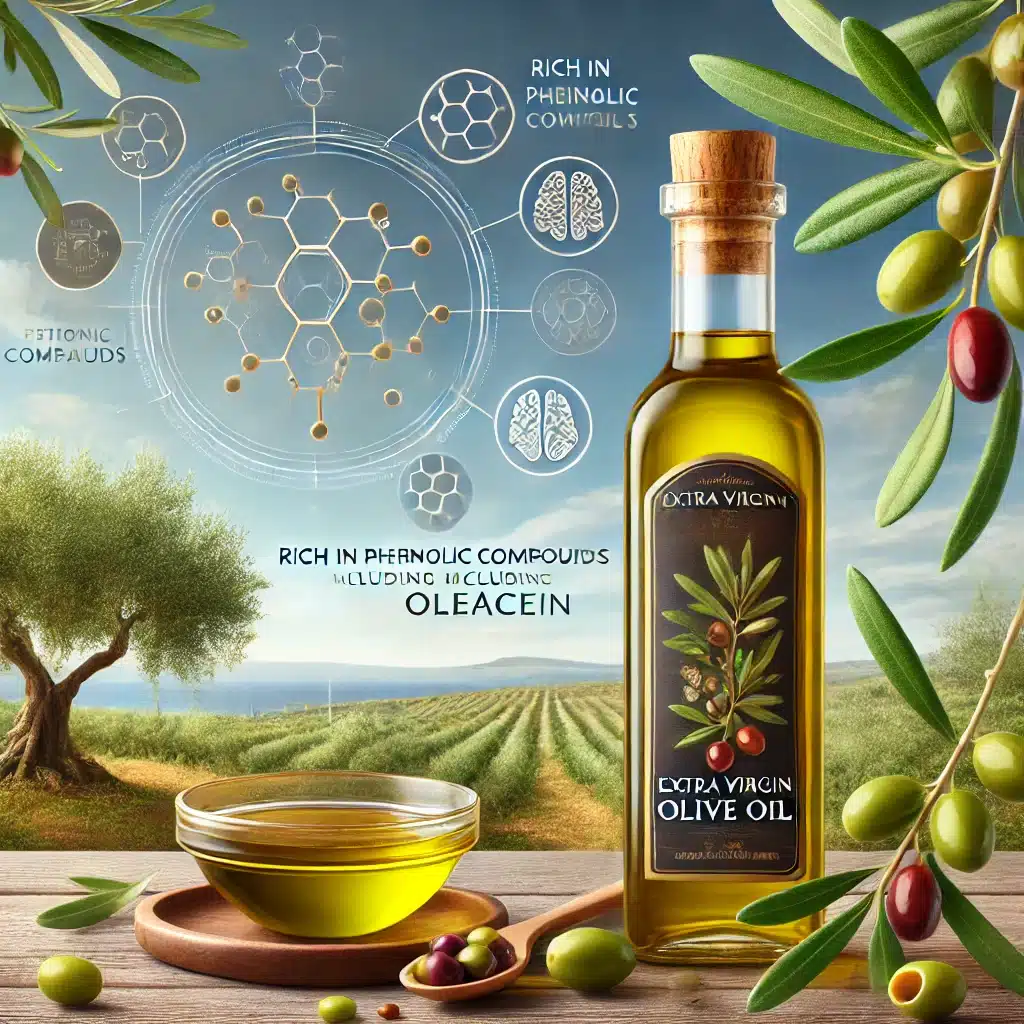Oleacein, a compound found in extra virgin olive oil, shows potential as a natural treatment for depression and anxiety by reducing inflammation and boosting brain-derived neurotrophic factor (BDNF).
Highlights:
- Oleacein & BDNF: Oleacein significantly increases BDNF expression, which is essential for brain health and neuroplasticity, both in human neuroblastoma cells and in the brains of treated mice.
- Inflammation Reduction: The compound effectively decreases the expression of pro-inflammatory cytokines (Tnfα, Il6, Il1β) in both cell cultures and mouse models, helping to mitigate neuroinflammation.
- Depression Model: In a mouse model of depression induced by inflammation, oleacein reduced immobility time in the tail suspension test, indicating its potential antidepressant effects comparable to fluoxetine, a standard antidepressant drug.
- Binding Affinity: Oleacein binds strongly to the TrkB receptor, which mediates the effects of BDNF, with a stronger and more stable affinity than the known TrkB agonist 7,8-dihydroxyflavone.
- Gene Modulation: Transcriptomics analysis revealed that oleacein upregulates genes related to cell cycle and neurogenesis while downregulating inflammation-associated genes under inflammatory conditions.
Source: Cell Communication & Signaling (2024)
Olive Oil: Health Benefits & Key Compounds (Overview)
Health Effects
Olive oil, especially extra virgin olive oil (EVOO), is a cornerstone of the Mediterranean diet, renowned for its numerous health benefits.
Rich in monounsaturated fats, antioxidants, and anti-inflammatory compounds, olive oil is associated with various positive health outcomes, including:
Cardiovascular Health: Regular consumption of olive oil is linked to lower risks of heart disease and stroke due to its ability to improve cholesterol levels and reduce blood pressure.
Anti-inflammatory Properties: The anti-inflammatory compounds in olive oil can help reduce chronic inflammation, which is a risk factor for many diseases.
Antioxidant Effects: Olive oil is high in antioxidants, such as vitamin E and polyphenols, which protect cells from damage caused by free radicals.
Key Compounds
Olive oil contains several bioactive compounds that contribute to its health benefits:
Oleic Acid: The primary monounsaturated fat in olive oil, oleic acid, helps reduce inflammation and has beneficial effects on genes linked to cancer.
Hydroxytyrosol: A potent antioxidant that protects cells from damage and has anti-inflammatory properties.
Oleuropein: Known for its ability to lower blood pressure and improve heart health, oleuropein also exhibits antimicrobial properties.
Oleocanthal: This compound has strong anti-inflammatory effects similar to ibuprofen, making it beneficial for reducing pain and inflammation.
Oleacein: A Rare Compound
Oleacein is a rare secoiridoid derivative found in extra virgin olive oil, characterized by its potent bioactive properties:
- Chemical Structure: Oleacein shares a similar structure with oleocanthal but has an additional phenolic hydroxyl group, enhancing its biological activities.
- Health Effects: Recent studies have shown that oleacein possesses significant anti-inflammatory and neuroprotective effects. It can increase brain-derived neurotrophic factor (BDNF) levels, reduce inflammation, and promote neuroplasticity.
- Potential Uses: Due to its strong binding affinity to the TrkB receptor and ability to modulate key signaling pathways, oleacein shows promise as a natural therapeutic agent for treating depression and anxiety-related disorders.
Major Findings: Oleacein with Neuroprotective & Antidepressant Effects (2024 Study)

1. Oleacein Increases BDNF Expression
Human Neuroblastoma Cells (SH-SY5Y): Oleacein significantly boosted BDNF expression in a dose-dependent manner. This effect was blocked when cells were treated with inhibitors targeting the BDNF receptor (TrkB) and its downstream signaling pathways, indicating that oleacein works through the BDNF/TrkB pathway.
Mouse Brain: A single oral dose of oleacein led to a significant increase in BDNF levels in the brains of treated mice, as observed through bioluminescence imaging.
2. Oleacein Reduces Inflammation
Cell Studies: When SH-SY5Y cells were treated with lipopolysaccharide (LPS) to induce inflammation, oleacein reduced the expression of inflammation-related genes. This suggests that oleacein can counteract inflammation at the cellular level.
Mouse Model: In mice subjected to LPS-induced inflammation, oleacein decreased the expression of key pro-inflammatory cytokines (Tnfα, Il6, Il1β) in the hippocampus, a critical brain region involved in mood regulation.
3. Antidepressant-like Effects in Mice
Mice treated with oleacein showed significantly reduced immobility time in the tail suspension test, a standard test used to measure depressive-like behavior in animals.
The effect of oleacein was comparable to fluoxetine, a widely used antidepressant.
4. Binding Affinity to TrkB Receptor
Oleacein demonstrated a stronger and more stable binding affinity to the TrkB receptor compared to 7,8-dihydroxyflavone, a known TrkB agonist.
This strong binding suggests that oleacein can effectively activate the BDNF/TrkB signaling pathway.
5. Gene Modulation
Normal Conditions: Under non-inflammatory conditions, oleacein upregulated genes related to the cell cycle, promoting cell growth and proliferation.
Inflammatory Conditions: In conditions of inflammation induced by LPS, oleacein downregulated genes associated with inflammation and upregulated genes involved in neuroprotection and cell survival. This dual action helps in both reducing inflammation and supporting brain health.
6. Overall Impact on Brain Health
ProBDNF & mBDNF Levels: Oleacein reduced levels of proBDNF (which can promote cell death) and increased levels of mature BDNF (which supports cell survival and growth) in the hippocampus of treated mice.
Transcriptomics Analysis: Comprehensive gene expression analysis confirmed that oleacein’s treatment led to beneficial changes in gene expression profiles, supporting both reduced inflammation and enhanced neuroprotection.
Study Details: Oleacein Effects (2024 Research)

The study aimed to evaluate the neuroprotective effects of oleacein, a rare compound found in extra virgin olive oil.
Specifically, it focused on investigating oleacein’s potential to modulate brain-derived neurotrophic factor (BDNF)/TrkB signaling and its ability to reduce neuroinflammation in models of depression and anxiety.
Sample
- In Vitro Sample: Human neuroblastoma cells (SH-SY5Y) were used to assess the cellular effects of oleacein on BDNF expression and neuroinflammatory responses.
- In Vivo Sample: Male 8-week-old ICR mice were utilized to study the effects of oleacein on behavior and gene expression in a model of LPS-induced depression.
Methods
Cell Culture and Treatment:
- SH-SY5Y Cells: These human neuroblastoma cells were treated with varying concentrations of oleacein to measure BDNF expression and to assess the anti-inflammatory effects under lipopolysaccharide (LPS)-induced inflammatory conditions.
- Inhibitor Studies: Co-treatment with inhibitors of TrkB, PI3K, and MEK was performed to identify the signaling pathways involved in oleacein’s action.
Gene Expression Analysis:
- Real-Time PCR: Quantitative real-time PCR was used to measure the expression levels of BDNF and inflammatory cytokines (Tnfα, Il6, Il1β) in both SH-SY5Y cells and mouse hippocampal tissue.
- Transcriptomics: Whole-transcriptomics analysis was conducted to identify changes in gene expression profiles in response to oleacein treatment under both normal and inflammatory conditions.
Behavioral Testing in Mice:
- Tail Suspension Test (TST): Mice were subjected to the TST to evaluate the antidepressant-like effects of oleacein by measuring immobility time after LPS-induced depressive-like behavior.
Binding Affinity Studies:
- Surface Plasmon Resonance (SPR): SPR assays were used to measure the binding affinity of oleacein to the TrkB receptor, comparing it to known TrkB agonists.
Bioluminescence Imaging:
- AkaLuciferase Imaging: The Bdnf-IRES-AkaLuc mice model was used to visualize and quantify BDNF expression in vivo following oleacein treatment.
Limitations
- Limited Sample Diversity: The study primarily used SH-SY5Y cell lines and ICR mice, which may not fully capture the complexity of human neuroinflammatory and depressive conditions.
- Single Dosage & Duration: The study evaluated the effects of a specific dosage of oleacein over a limited period. Long-term effects and optimal dosing regimens were not explored.
- Mechanistic Insights: While the study identified key signaling pathways involved, it did not delve deeply into the detailed mechanistic interactions at the molecular level.
- Translational Gap: Further studies are needed to confirm whether the observed effects in cell lines and mice models translate to humans, given the biological differences.
Potential Applications of Oleacein in Humans

1. Treatment of Depression & Anxiety Disorders
Oleacein’s ability to increase BDNF levels and enhance neuroplasticity suggests it could be used as a natural treatment for depression and anxiety.
By modulating the BDNF/TrkB pathway, oleacein can promote neuronal growth and improve mood regulation.
Given its potent anti-inflammatory properties, oleacein could help reduce neuroinflammation, which is often linked to mood disorders.
This dual action on both inflammation and neuroplasticity makes it a promising candidate for managing depression and anxiety.
2. Neuroprotection & Cognitive Enhancement
Oleacein’s neuroprotective effects indicate potential applications in conditions like Alzheimer’s and Parkinson’s diseases.
By reducing inflammation and supporting neuronal health, oleacein could slow disease progression and improve cognitive function.
Regular intake of oleacein could support overall brain health, potentially enhancing memory and cognitive abilities in healthy individuals and those with mild cognitive impairment.
3. Anti-Inflammatory Therapies
Beyond neurological disorders, oleacein’s strong anti-inflammatory effects could be beneficial in treating chronic inflammatory diseases such as arthritis, inflammatory bowel disease, and other autoimmune conditions.
Similar to oleocanthal, oleacein may offer pain relief by reducing inflammation, providing a natural alternative to synthetic anti-inflammatory drugs with fewer side effects.
4. Cardiovascular Health
By lowering inflammation, oleacein could help reduce the risk of heart disease.
Its antioxidative properties also contribute to the protection of blood vessels and overall cardiovascular health.
Oleacein might aid in managing cholesterol levels, thus contributing to a healthier lipid profile and reducing cardiovascular risk factors.
5. Metabolic Health
Inflammation plays a significant role in the development of insulin resistance and type 2 diabetes.
Oleacein’s anti-inflammatory properties could help improve insulin sensitivity and glycemic control in diabetic patients.
As part of a balanced diet, oleacein might support weight management efforts by reducing inflammation-related metabolic issues.
6. Skin Health
Oleacein’s antioxidant properties can protect the skin from oxidative stress, potentially reducing signs of aging and promoting a youthful appearance.
Conditions like psoriasis and eczema, characterized by chronic inflammation, could benefit from the topical application of oleacein or its inclusion in skincare products.
Is Oleacein Available as a Dietary Supplement?
Currently, oleacein is not widely available as a standalone supplement.
It is a rare compound primarily found in extra virgin olive oil, and its extraction and production for commercial purposes are still under research and development.
While some specialized health product manufacturers might offer supplements containing oleacein, these are not commonly found in mainstream health stores.
- References
- Study: A rare olive compound oleacein functions as a TrkB agonist and mitigates neuroinflammation both in vitro and in vivo (2024)
- Authors: Daiki Wakasugi et al.







